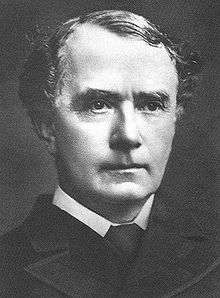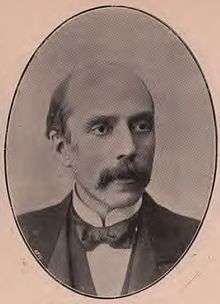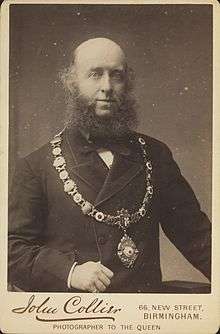Birmingham East (UK Parliament constituency)
Birmingham East was a parliamentary constituency in the city of Birmingham, England. It returned one Member of Parliament (MP) to the House of Commons of the Parliament of the United Kingdom, elected by the first-past-the-post voting system.
| Birmingham East | |
|---|---|
| Former Borough constituency for the House of Commons | |
| County | Warwickshire |
| 1885–1918 | |
| Number of members | One |
| Replaced by | Birmingham Yardley, Birmingham Sparkbrook |
| Created from | Birmingham |
The constituency was created upon the abolition of the Birmingham constituency in 1885, and was itself abolished for the 1918 general election.
Boundaries
Before 1885 Birmingham, in the county of Warwickshire, had been a three-member constituency (see Birmingham (UK Parliament constituency) for further details). Under the Redistribution of Seats Act 1885 the parliamentary borough of Birmingham was split into seven single-member divisions, one of which was Birmingham East. It consisted of the wards of Duddeston and Nechells, the local government district of Saltley, and the hamlet of Little Bromwich.
The division was bounded to the west by Birmingham North, to the north by Aston Manor, to the east by Tamworth and to the south (from west to east) by Birmingham Central, Birmingham South and Birmingham Bordesley.
In the 1918 redistribution of parliamentary seats, the Representation of the People Act 1918 provided for twelve new Birmingham divisions. The East division was abolished.
Members of Parliament
| Election | Member | Party | |
|---|---|---|---|
| 1885 | William Cook | Liberal | |
| 1886 | Henry Matthews | Conservative | |
| 1895 | Sir John Benjamin Stone | Conservative | |
| 1910 (Jan) | Arthur Steel-Maitland | Conservative | |
| 1918 | Constituency abolished | ||
Elections
Elections in the 1880s
.jpg)
| Party | Candidate | Votes | % | ± | |
|---|---|---|---|---|---|
| Liberal | William Cook | 4,277 | 58.6 | N/A | |
| Conservative | Francis Lowe | 3,025 | 41.4 | N/A | |
| Majority | 1,252 | 17.2 | N/A | ||
| Turnout | 7,302 | 77.8 | N/A | ||
| Registered electors | 9,382 | ||||
| Liberal win (new seat) | |||||

| Party | Candidate | Votes | % | ± | |
|---|---|---|---|---|---|
| Conservative | Henry Matthews | 3,341 | 56.7 | +15.3 | |
| Liberal | William Cook | 2,552 | 43.3 | -15.3 | |
| Majority | 789 | 13.4 | N/A | ||
| Turnout | 5,893 | 62.8 | -15.0 | ||
| Registered electors | 9,382 | ||||
| Conservative gain from Liberal | Swing | +15.3 | |||
Matthews was appointed Home Secretary, requiring a by-election.
| Party | Candidate | Votes | % | ± | |
|---|---|---|---|---|---|
| Conservative | Henry Matthews | Unopposed | |||
| Conservative hold | |||||
Elections in the 1890s

| Party | Candidate | Votes | % | ± | |
|---|---|---|---|---|---|
| Conservative | Henry Matthews | 5,041 | 61.7 | +5.0 | |
| Liberal | Henry Charles Fulford | 2,832 | 34.7 | −8.6 | |
| Independent Liberal | Daniel Shilton Collin[n 1] | 296 | 3.6 | N/A | |
| Majority | 2,209 | 27.0 | +13.6 | ||
| Turnout | 8,169 | 78.5 | +15.7 | ||
| Registered electors | 10,404 | ||||
| Conservative hold | Swing | +6.8 | |||

| Party | Candidate | Votes | % | ± | |
|---|---|---|---|---|---|
| Conservative | John Benjamin Stone | Unopposed | |||
| Conservative hold | |||||
Elections in the 1900s
| Party | Candidate | Votes | % | ± | |
|---|---|---|---|---|---|
| Conservative | John Benjamin Stone | 4,989 | 63.8 | N/A | |
| Lib-Lab | John Valentine Stevens | 2,835 | 36.2 | N/A | |
| Majority | 2,154 | 27.6 | N/A | ||
| Turnout | 7,824 | 59.9 | N/A | ||
| Registered electors | 13,070 | ||||
| Conservative hold | Swing | N/A | |||
| Party | Candidate | Votes | % | ± | |
|---|---|---|---|---|---|
| Conservative | John Benjamin Stone | 5,928 | 52.6 | −11.2 | |
| Labour Repr. Cmte. | James Holmes | 5,343 | 47.4 | +11.2 | |
| Majority | 585 | 5.2 | −22.4 | ||
| Turnout | 11,271 | 77.9 | +18.0 | ||
| Registered electors | 14,469 | ||||
| Conservative hold | Swing | −11.2 | |||
Elections in the 1910s
| Party | Candidate | Votes | % | ± | |
|---|---|---|---|---|---|
| Conservative | Arthur Steel-Maitland | 8,460 | 68.1 | +15.5 | |
| Labour | J. J. Stephenson | 3,958 | 31.9 | -15.5 | |
| Majority | 4,502 | 36.2 | +31.0 | ||
| Turnout | 81.5 | +1.6 | |||
| Conservative hold | Swing | 15.5 | |||
| Party | Candidate | Votes | % | ± | |
|---|---|---|---|---|---|
| Conservative | Arthur Steel-Maitland | 6,639 | 67.5 | -0.6 | |
| Lib-Lab | John Valentine Stevens | 3,190 | 32.5 | ||
| Majority | 3,449 | 35.0 | -1.2 | ||
| Turnout | 64.5 | -17.0 | |||
| Conservative hold | Swing | -1.2 | |||
General Election 1914/15:
Another General Election was required to take place before the end of 1915. The political parties had been making preparations for an election to take place and by July 1914, the following candidates had been selected;
- Unionist: Arthur Steel-Maitland
- Labour: George Shann
In popular culture
Birmingham East was used in BBC sitcom Yes, Minister, and Jim Hacker was its MP. Although Hacker's Party was left unspecified, he was shown to be elected in the fictional 1981 general election, defeating a Conservative and Labour challenger.
| Party | Candidate | Votes | % | ± | |
|---|---|---|---|---|---|
| n/a | James George Hacker | 21,793 | 48.2 | ||
| n/a | Arthur William Gaunt | 19,321 | 42.7 | ||
| n/a | David Lloyd Evans | 4,106 | 9.1 | ||
| Majority | 2,472 | 5.5 | |||
| Turnout | 45,220 | ||||
| n/a hold | Swing | ||||
See also
- List of former United Kingdom Parliamentary constituencies
Notes and References
Notes
- Collin was associated with the United Kingdom Alliance
References
- British Parliamentary Election Results 1885-1918, FWS Craig
- The Liberal Year Book, 1907
- Debrett's House of Commons & Judicial Bench, 1886
- Debrett's House of Commons & Judicial Bench, 1896
- Debrett's House of Commons & Judicial Bench, 1901
- Debrett's House of Commons & Judicial Bench, 1916
- Boundaries of Parliamentary Constituencies 1885-1972, compiled and edited by F.W.S. Craig (Parliamentary Reference Publications 1972)
- British Parliamentary Election Results 1885-1918, compiled and edited by F.W.S. Craig (Macmillan Press 1974)
- Debrett’s Illustrated Heraldic and Biographical House of Commons and the Judicial Bench 1886
- Debrett’s House of Commons and the Judicial Bench 1901
- Debrett’s House of Commons and the Judicial Bench 1918
- Leigh Rayment's Historical List of MPs – Constituencies beginning with "B" (part 3)